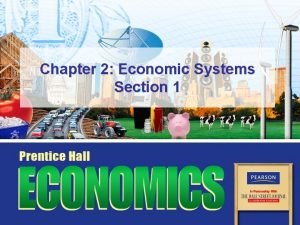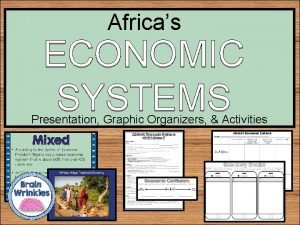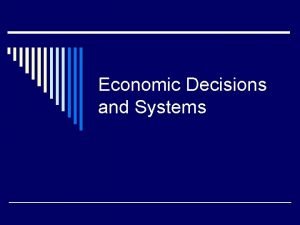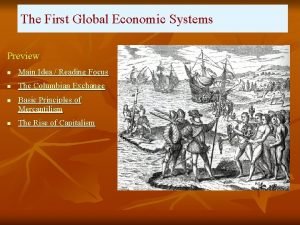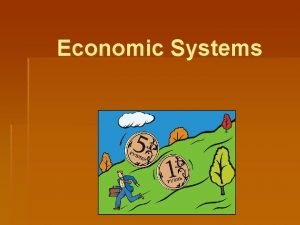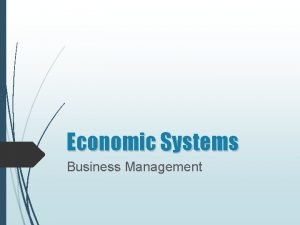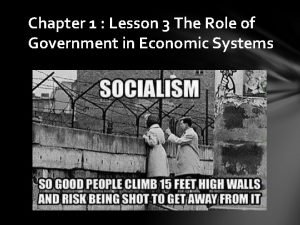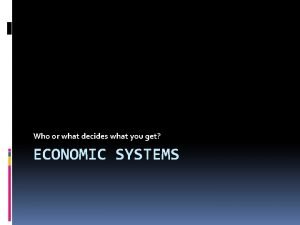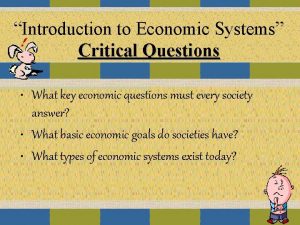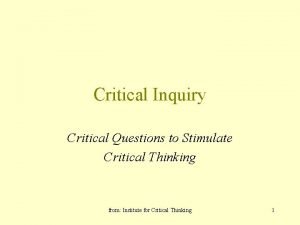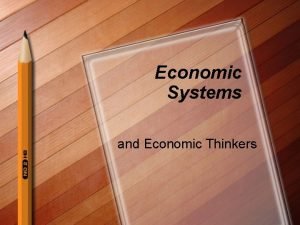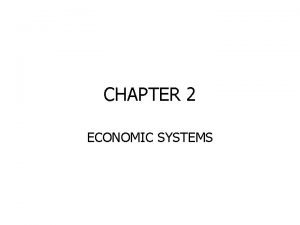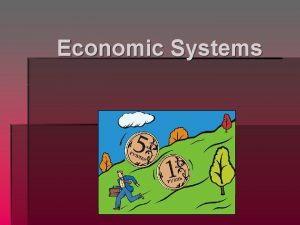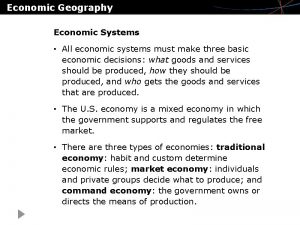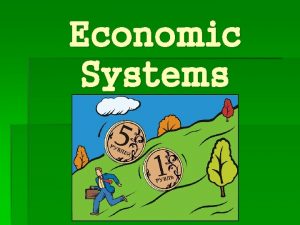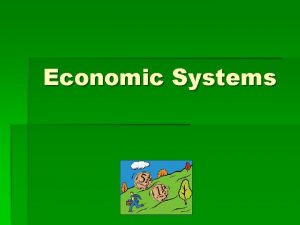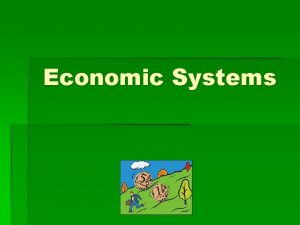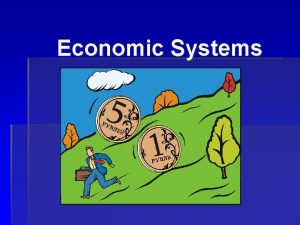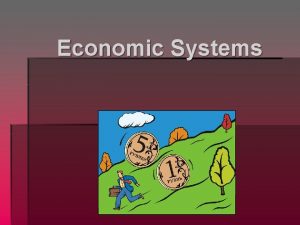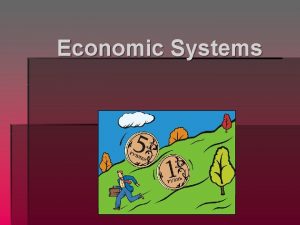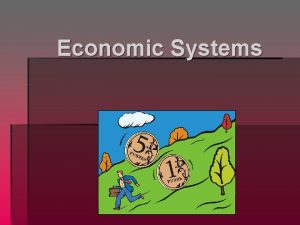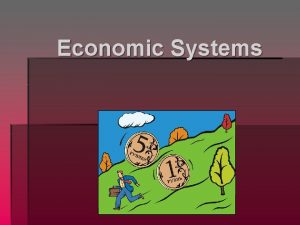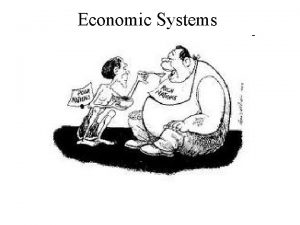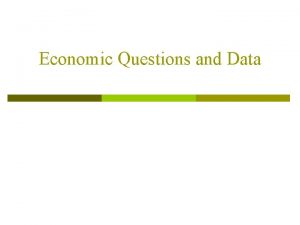Introduction to Economic Systems Critical Questions What key























- Slides: 23

“Introduction to Economic Systems” Critical Questions • What key economic questions must every society answer? • What basic economic goals do societies have? • What types of economic systems exist today?

What is an economic system? The method used by a society to produce and distribute goods and services

The Three Questions that Determine a Societies Economic System Because ALL economic resources are scarce, every society must answer three questions: – What goods and services should be produced? • Guns or butter? – How should these goods and services be produced? • What combination of factor resources should we use? – Who consumes these goods and services? • How will income be distributed?

• Every society has some system or mechanism that transforms that society’s scarce resources into useful goods and services.

Four Economic Systems An economic system is the method used by a society to produce and distribute goods and services. Traditional economies rely on habit, custom, or ritual to decide what to produce, how to produce it, and to whom to distribute it. In a market economy economic decisions are made by individuals and are based on exchange, or trade. In a centrally planned economy the central government makes all decisions about the production and consumption of goods and services. Mixed economies are systems that combine tradition and the free market with limited government intervention.

Comparing Economic Systems Economic System Who answers the 3 ? ’s • • Traditional Market Command Mixed Customs Individuals Central Government Individuals with some government involvement

Traditional System • A traditional system relies on habit, custom or ritual to decide what to produce, how to produce it and to who to distribute it. • Agricultural and hunting societies

• There is little room for innovation or change. • They tend to lack modern conveniences and have a low standard of living. • Close knit communities with focus on the family unit.

Traditional Economy • Found in rural, underdeveloped countries– – – Vanuatu Pygmies of Congo Eskimos & Indian tribes Belarus • Customs govern the economic decisions that are made • Farming, hunting and gathering are done the same way as the generation before • Economic activities are centered around the family or ethnic unit • Men and women are given different economic roles and tasks • Advantages: people have specific roles; security in the way things are done • Disadvantages: Technology is not used; difficult to improve

Why Do Markets Exist? Markets exist because none of us produces all the goods and services we require to satisfy our needs and wants. A market is an arrangement that allows buyers and sellers to exchange goods and services. Specialization is the concentration of the productive efforts of individuals and firms on a limited number of

Free Markets Circular Flow Diagram of a Market Economy • In a free market economy, households and business firms use markets to exchange money and products. Households • Households own the factors of production and consume goods and services. monetary flow physical flow Firms physical flow monetary flow

Advantages of the Economic Efficiency Market • As a self-regulating system, a free market economy is efficient. Economic Growth • Because competition encourages innovation, free markets encourage growth. Economic Freedom • Free market economies have the highest degree of economic freedom of any economic system. Additional Goals • Free markets offer a wider variety of goods and services than any other economic system.

Market Economy (Free Enterprise) • Supply and demand of • Also called a Free Market goods and services Economy or Free Enterprise determine what is produced Economy and the price that will be • Businesses and consumers charged. decide what they will produce and purchase and in • Advantage—competition to have the best products and what quantities services • Decisions are made according to law of supply • Disadvantage—huge rift between wealthy and poor & demand • Note: a true market economy does not exist.

Command Economies The government, or central authority controls the economy.

Organization of Command Economies In a command economy, the government owns both land capital. The government decides what to produce, how much to produce, and how much to charge. Socialism is a social and political philosophy based on the belief that democratic means should be used to distribute wealth evenly throughout a society. Communism is a political system characterized by a centrally planned economy with all economic and political power resting in the hands of the government. Communist governments are authoritarian in nature.

Command Economy • The government (or central authority) determines what, how, and for whom goods and services are produced. • Two types: • Advantages – Guarantees equal standard of living for everyone – Less crime and poverty – Needs are provided for through the government – Strong Command – where government makes all • Disadvantages decisions (communism – – Minimal choices China, Cuba) – Fewer choices of items – Moderate Command – where – No incentive to produce some form of private better product or engage in enterprise exists but the state entrepreneurship owns major resources (socialism – France and • Also known as a Planned or Sweden) Managed Economy

The Soviet Experiment • Land, labor and capital was all controlled by the state. The best resources were allocated to to the armed forces, space program, and production of capital goods. • Government committees decided the quantity, process and distribution of all products. • The government created large state-owned farms and collectives to produce all agricultural products. • Under this system there was little incentive to produce, and the Soviet Union saw a rapid decline in the production of agricultural goods.

The Meaning Behind the Flag The hammer and sickle originate from the unique Russian unity of the peasants (the sickle) with the workers (the hammer) who together formed the Soviet Russian state. • The Red field is symbolism of the blood that has been spilt by workers the world over in the fight for their emancipation. • The single yellow star is the representation of the life and immense energy of the sun, empty because within is the blood or production of workers struggle.

Command economy face problems of poor-quality goods, shortages, and diminishing production.

Other Problems in Centrally Planned Economies • • • Performance falls short of the set ideals Fail to meet consumer needs and wants Little individual incentives to work hard Lack of improvement Expensive and inflexible government structure needed to manage the system • Sacrifice of individual freedoms to pursue societal goals

Mixed Economies • It is doubtable that any nation can exist successfully under a pure command economy or a pure market economy. • Most economies mix features of both systems.

Mixed Economy • Most nations have a • Combination of a market and a command economy • Government takes of people’s needs • Marketplace takes care of people’s wants. mixed economy: United States, England, Australia • Advantage —balance of needs and wants met by government and in marketplace • Disadvantage —citizens have to pay taxes

An economic system that permits the conduct of business with minimal government intervention is called free enterprise. The degree of government involvement in the economy varies among nations. Nations are placed on a continuum (a range with no clear divisions) of mixed economies. On one end are centrally planned economies and on the opposite end are free markets economies. Continuum of Mixed Economies Centrally planned Free market Iran North Korea Cuba South Africa China Russia France Botswana Greece United Kingdom Canada Peru Hong Kong Singapore United States Source: 1999 Index of Economic Freedom, Bryan T. Johnson, Kim R. Holmes, and Melanie Kirkpatrick Comparing Mixed Economies
 Critical semi critical and non critical instruments
Critical semi critical and non critical instruments Spaulding classification of medical devices ppt
Spaulding classification of medical devices ppt Chapter 1 lesson 2 our economic choices worksheet answers
Chapter 1 lesson 2 our economic choices worksheet answers Africa's economic systems comprehension check answer key
Africa's economic systems comprehension check answer key Chapter 2 economic systems answer key
Chapter 2 economic systems answer key Africa's economic systems cloze notes 2
Africa's economic systems cloze notes 2 Chapter 2 economic systems and decision making
Chapter 2 economic systems and decision making Chapter 2 economic systems and decision making answer key
Chapter 2 economic systems and decision making answer key Chapter 1 economic decisions and systems answer key
Chapter 1 economic decisions and systems answer key Comparing economic systems worksheet
Comparing economic systems worksheet The first global economic systems answer key
The first global economic systems answer key Critical reading meaning
Critical reading meaning Economic growth vs economic development
Economic growth vs economic development Conclusion of growth and development
Conclusion of growth and development Business model canvas key partner
Business model canvas key partner Business model canvas tripadvisor
Business model canvas tripadvisor What economic system is germany
What economic system is germany Economic systems examples
Economic systems examples How many economic systems are there
How many economic systems are there Scarcity political cartoon
Scarcity political cartoon Chapter 2 economic systems and decision making
Chapter 2 economic systems and decision making Lesson 3 the role of government in economic systems
Lesson 3 the role of government in economic systems Who or what decides what you get?
Who or what decides what you get? Free enterprise system def
Free enterprise system def




